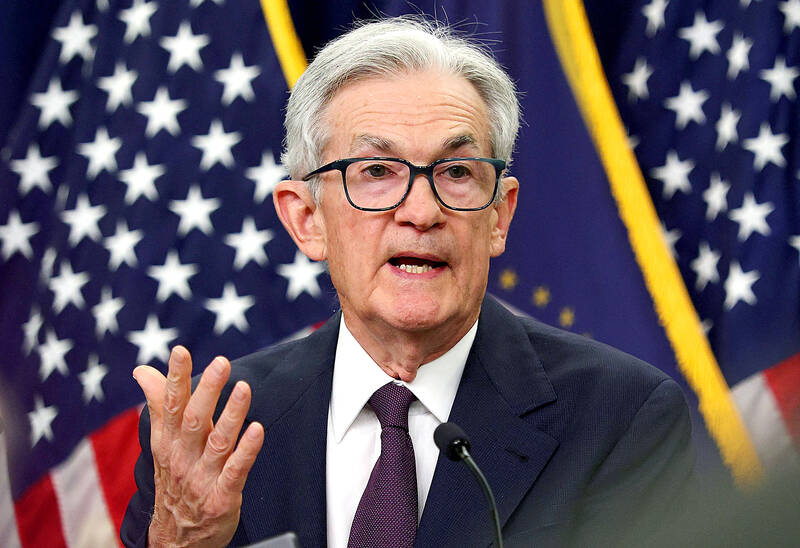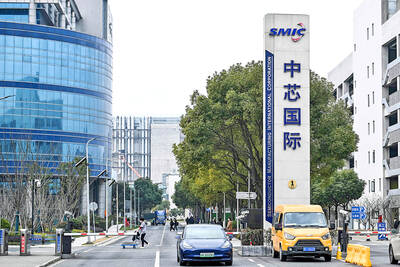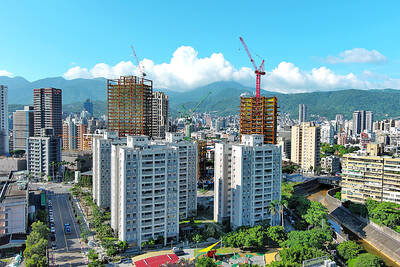There are a lot of unknowns about the outlook for the economy and interest rates, but US Federal Reserve Chair Jerome Powell signaled at least one thing seems certain: Higher prices are coming.
Fed policymakers voted unanimously to hold interest rates steady at a range of 4.25 percent to 4.50 percent for a fourth straight meeting on Wednesday, as they await clarity on whether tariffs would leave a one-time or more lasting mark on inflation.
Powell said it is still unclear how much of the bill would fall on the shoulders of consumers, but he expects to learn more about tariffs this summer.

Photo: Getty Images via AFP
“Ultimately, the cost of the tariff has to be paid, and some of it will fall on the end consumer,” Powell said. “We know that’s coming, and we just want to see a little bit of that before we make judgments prematurely.”
However, policymakers’ latest economic projections suggest a growing divide on the committee. While the median forecast in the so-called dot plot continued to show two rate cuts this year, seven officials see no reductions this year, compared with 10 policymakers who foresee two or more.
“They were unanimous in terms of not doing anything right now, but I think they’re divided in terms of how they view the risks,” JPMorgan Asset Management Inc portfolio manager Priya Misra said. “I think the division in the dots for 2025 comes down to how different participants view the persistence of inflation.”
Asked about the division in officials’ rate projections, Powell downplayed it, saying that given the high level of uncertainty in the economy, “no one holds these rate paths with a lot of conviction.”
For some time, policymakers have been expecting higher unemployment and inflation as a result of US President Donald Trump’s policy changes, particularly around trade. Several officials, including Powell, have highlighted the central bank’s commitment to ensuring price pressures do not become more persistent.
So far, the economy has proved resilient, with inflation rising less than expected over the past few months and unemployment holding steady.
Uncertainty has diminished, but remains elevated, Fed officials said in a post-meeting statement.
Policy should be forward looking, Powell said, adding that officials are beginning to see some effects from tariffs, but expect more over the coming months.
While forecasters expect a “meaningful” rise in inflation, Powell said the jobs market is not “crying out for a rate cut.”
Policymakers dropped a line from the previous statement that said risks to unemployment and inflation had risen. Yet, the median estimate showed the Fed’s preferred price gauge rising 3 percent this year, up from the 2.1 percent increase seen in the year through April. Meanwhile, officials downgraded their estimates for economic growth this year and lifted their forecast for unemployment slightly.
Investors see a more than 70 percent chance of a rate cut in September, but most economists said it could take until at least then to understand the impact of trade, immigration and spending policies, and policymakers do not appear to be in a hurry, Bloomberg survey showed.
“The Fed is very much on the sidelines, they’re waiting,” Santander US Capital Markets LLC chief economist Stephen Stanley said. “Maybe by September we’ll have some answers. That’ll be the best case at this point.”

NO BREAKTHROUGH? More substantial ‘deliverables,’ such as tariff reductions, would likely be saved for a meeting between Trump and Xi later this year, a trade expert said China launched two probes targeting the US semiconductor sector on Saturday ahead of talks between the two nations in Spain this week on trade, national security and the ownership of social media platform TikTok. China’s Ministry of Commerce announced an anti-dumping investigation into certain analog integrated circuits (ICs) imported from the US. The investigation is to target some commodity interface ICs and gate driver ICs, which are commonly made by US companies such as Texas Instruments Inc and ON Semiconductor Corp. The ministry also announced an anti-discrimination probe into US measures against China’s chip sector. US measures such as export curbs and tariffs

The US on Friday penalized two Chinese firms that acquired US chipmaking equipment for China’s top chipmaker, Semiconductor Manufacturing International Corp (SMIC, 中芯國際), including them among 32 entities that were added to the US Department of Commerce’s restricted trade list, a US government posting showed. Twenty-three of the 32 are in China. GMC Semiconductor Technology (Wuxi) Co (吉姆西半導體科技) and Jicun Semiconductor Technology (Shanghai) Co (吉存半導體科技) were placed on the list, formally known as the Entity List, for acquiring equipment for SMIC Northern Integrated Circuit Manufacturing (Beijing) Corp (中芯北方積體電路) and Semiconductor Manufacturing International (Beijing) Corp (中芯北京), the US Federal Register posting said. The

India’s ban of online money-based games could drive addicts to unregulated apps and offshore platforms that pose new financial and social risks, fantasy-sports gaming experts say. Indian Prime Minister Narendra Modi’s government banned real-money online games late last month, citing financial losses and addiction, leading to a shutdown of many apps offering paid fantasy cricket, rummy and poker games. “Many will move to offshore platforms, because of the addictive nature — they will find alternate means to get that dopamine hit,” said Viren Hemrajani, a Mumbai-based fantasy cricket analyst. “It [also] leads to fraud and scams, because everything is now

MORTGAGE WORRIES: About 34% of respondents to a survey said they would approach multiple lenders to pay for a home, while 29.2% said they would ask family for help New housing projects in Taiwan’s six special municipalities, as well as Hsinchu city and county, are projected to total NT$710.65 billion (US$23.61 billion) in the upcoming fall sales season, a record 30 percent decrease from a year earlier, as tighter mortgage rules prompt developers to pull back, property listing platform 591.com (591新建案) said yesterday. The number of projects has also fallen to 312, a more than 20 percent decrease year-on-year, underscoring weakening sentiment and momentum amid lingering policy and financing headwinds. New Taipei City and Taoyuan bucked the downturn in project value, while Taipei, Hsinchu city and county, Taichung, Tainan and Kaohsiung